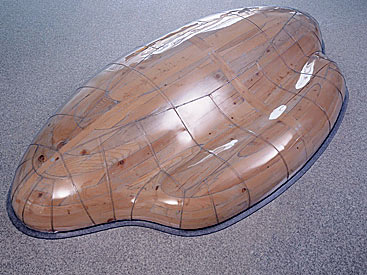
Born in 1949 in Bangor (GB)
Lives and works in London (GB) and Paris (FR)

1991
Wood, welded PVC
48 x 335 x 171 cm
Actuellement en dépôt : Musée départemental d'art ancien et contemporain, Epinal
Year of Purchase: 1992
Richard Deacon’s sculptures are smooth, shiny, supple shapes which the eye glides over; they assume forms, dimensions and presentation methods which differ a great deal. They are classical in the fullest sense of the word, even though the materials used are very alien to any academic aesthetic; they make use of all the wealth of colour and effects of these selected materials: steel and galvanized iron, zinc, polished wood, laminated hardboard, linoleum… Border (Lange) is a compact piece with a spare, round form, made of polished wood covered with a thick layer of see-through plastic. Preferring curves to corners, and line to mass, Border is set on the ground and through its scope and growth redraws the surrounding space and area.
By using techniques of dividing up and assemblage, as opposed to hollowing out from a bloc, Deacon diverts his materials from their natural properties, in order to shape them. What is more, Deacon deliberately leaves visible signs of this assemblage (bolts, glue…), as if he wanted to make the human trace apparent as author and recipient of the work. The titles of his pieces furthermore back up this analysis: Art for other people, Other Homes, Other Lives…
Though not exactly identifiable, his sculptures nevertheless conjure up the organs of perception; so the exhibition venue is conceived as a place ‘of audience’ where contact with viewers is created: the solid parts lend the voids a shape, in which man can be included. Deacon is concerned with blossoming and unfurling in space, as he is with music and dance. The indeterminacy of the forms he creates makes it possible to produce successful linkages between the arts (dances with Lucy Bethune in 1987 and Hervé Robbe in 1993).
Deacon’s works, which are unusual because they are obvious in their structural resoluteness, and ambiguous in their anthropomorphic analysis of the whole, refer back only to themselves, in fact, and to their sensual material qualities.
Anne Langlois